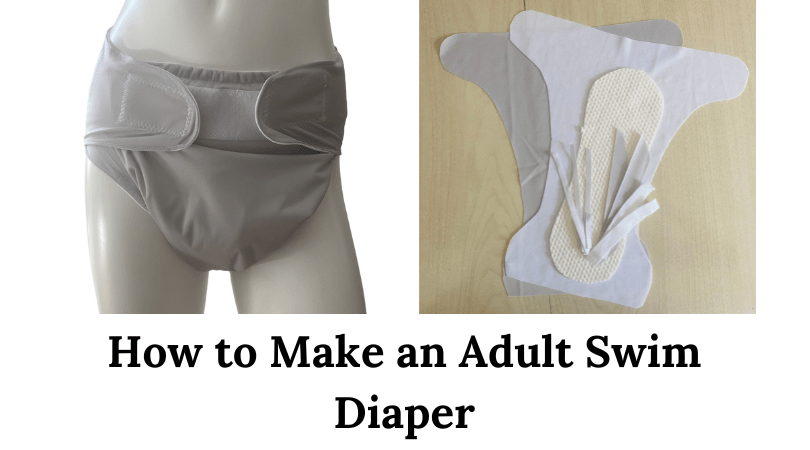Summertime is here and managing incontinence pool side can be challenging. A swim diaper’s main purpose is to contain fecal matter should it occur while swimming. This means that a snug fit is VERY important. However, they can still aid in preventing urinary incontinence accidents if used properly.
In this post, we’ll cover what a swim diaper is and how to make your own.
Table of Contents
- What is the Difference Between a Cloth Diaper and a Swim Diaper?
- Can I Use a Regular Cloth Diaper as a Swim Diaper?
- What is a Cloth Swim Diaper Made From?
- How to Use a Swim Diaper for Urinary Incontinence?
- How to Make an Adult Swim Diaper
- Materials Needed
- FInding a Pattern
- Sewing a Cloth Swim Diaper
What is the difference between a cloth diaper and a swim diaper?
A swim diaper is a specific style of diaper meant to be worn while swimming or playing in a pool, hot tub, or any body of water. Since they are meant to be worn in the water, they are made from materials that don’t absorb water and become heavy when wet.
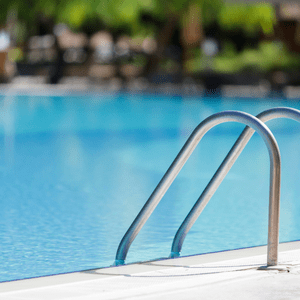
In addition, the main purpose of a swim diaper is to prevent fecal matter from getting into the water, not for containing bladder leaks. They have a trim fit meant to hug the body and prevent air bubbles from getting trapped in the swim diaper.
A cloth diaper or other cloth incontinence product, on the other hand, gets used to capture leaks from bladder and/or bowel incontinence. These items have a lot of absorbency in addition to a waterproof outer layer. The fit of a cloth diaper or other incontinence item can vary from trim fitting to bulky overnight.
Since cloth swim diapers are not meant to absorb and retain moisture, and thus do not have a lot of absorbency, they do not work as a substitute for a regular diaper (unless your incontinence is of the light bladder leak kind).
Can I Use a Regular Cloth Diaper as a Swim Diaper?
Again, the most important aspect of a swim diaper is its snug fit around the leg and waist. Swim diapers are designed to let the water flow through them and since there’s little or no absorbency on the inside. A cloth diaper with a lot of absorbency inside it runs the risk of getting waterlogged and heavy. The extra weight pulling down on the cloth diaper would cause gaping along the waist and legs, which would allow any accidents to leak out.
As for diaper covers, it’s possible that one could be used as a swim diaper, depending on the design. Diaper covers, like cloth diapers, come in different styles. To successfully use one as a swim diaper substitute, make sure that it is trim fitting and has a very snug fit around the waist and legs. Avoid adding any extra absorbency to the inside as this can cause the cover to sag.
Rubber or latex covers are completely waterproof and would work well to keep both urine and fecal matter contained as long as the fit is very snug. Trusty Trunks is a baby version of silicone swim diaper cover, and a rubber or latex cover would work similarly. The key is that absolutely no moisture would make its way into the cover once it’s in the water.
Finally, it’s important to keep in mind any regulations that a pool/facility has regarding swim diapers and follow them accordingly.
What is a Swim Diaper Made From?
A swim diaper is made from a combination of materials designed to be breathable, water-resistant, and comfortable. While the specific combination of materials varies from brand to brand, you can also make your own adult cloth swim diaper specifically for your needs. While different types of swim diapers exist, they all have basically the same composition.
- Lining
Most of the time, the lining is made from a polyester athletic mesh that has holes and allows water to flow through the item. Occasionally, a swim diaper will have a layer of polyester laminate instead, with the smooth laminate side going against the body.
2. Absorbent Layer (optional)
The purpose of an absorbent layer is to catch SMALL leaks when not in the water. These layers are thin so as not to weigh down the swim diaper when it gets wet. The majority of adult cloth swim diapers do not have this option.
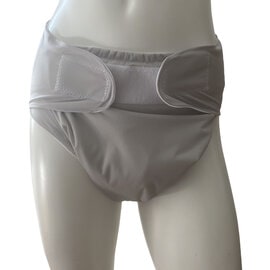
3. Waterproof Layer
Where the waterproof layer falls on a swim diaper depends on the stye of cloth swim diaper. Many have the entire outer layer as a laminate, waterproof layer. Some have the laminated layer as the inner lining. Still others may just have the waterproof layer sewn to the back of a thin absorbent layer between the lining and the outer layer.
4. Outer Layer (optional)
If the swim diaper has the waterproof layer as the lining or sewn to a thin absorbent core, the outer layer is often a nylon spandex that mimics the feel of a swimsuit.
Regardless of how the adult cloth swim diaper is made, they are not intended to be highly absorbent. Their primary purpose is to prevent solids from entering the water. To achieve this, they depend on a trim fit that snuggly hugs the legs and waist.
Using a Cloth Swim Diaper for Incontinence
To use a cloth swim diaper to help manage incontinence pool side, you first need to ask yourself how you want the item to function. If you don’t need to worry about bowel accidents and just want something that will prevent embarrassing leaks before entering the water, you’ll need to first determine the size of your leaks. For small bladder leaks, you can get away with leakproof swimwear that have a small amount of absorbency and waterproofing.
For larger leaks, a swim diaper will only manage to hold it for a VERY SHORT time. Even if you choose a swim diaper with a little absorbency and an entire outer of waterproofing, it’s only a matter of time before movement will cause the liquid to leak out.
Ultimately, swim diapers (cloth and disposable) are not meant to hold large accidents, so changing into a swim diaper shortly before entering the water and changing right after will be the best way to manage your incontinence while swimming.
How to Make an Adult Swim Diaper
The primary purpose of a cloth swim diaper is to prevent any solid accidents from contaminating the surrounding water. Thus, if they have absorbency, it’s only a small amount. A lot of absorbency is going to weigh down the item once it’s in the water, causing discomfort for the wearer and causing gaping at the legs and/or waist. This negates its ability to prevent any fecal accidents from entering the water.
However, many folks only deal with urinary incontinence, which can make it a little more tricky to find a product that will offer protection from leaks when not in the water. The style and type of adult cloth swim diaper depends on your unique combination of needs and lifestyle.
While there are a few options available for purchase, there’s not a lot. Making your own ensures that you can get a product that will work exactly how you need it to.
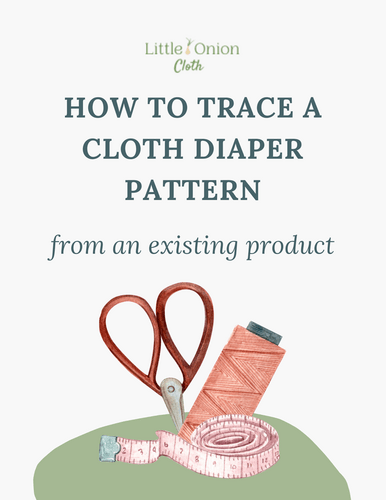
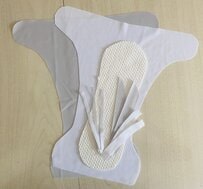
Materials Needed for Sewing an Adult Cloth Swim Diaper
The materials you use to make an adult cloth swim diaper depends primarily on the type of swim diaper you need. For instance, what level of incontinence do you have? Making an item that will catch light bladder leaks when you are not in the pool is different from something that will temporarily capture a full accident.
Remember, a swim diaper is not the same as a cloth diaper – it’s not meant to have a lot of absorbency since this will just get waterlogged once submersed. If you need full protection, you may have to change right before and after being in the water. If your swim diaper has a very snug fit along the legs and a full waterproof outer, it may buy you a short amount of time before leaking should you have a full bladder void.
1. Lining
Swim diapers typically have one of 2 types of fabric for the lining. Athletic mesh or laminate. If using laminate, sew with the sticky side up as the fabric side would stay wet against the skin and cause discomfort.
2. Absorbent core
If you’re looking for a swim diaper to offer you protection against bladder leaks when you’re not in the water, adding a small amount of absorbency to the inside of your cloth swim diaper can help. Just make sure to keep the absorbency thin since a swim diaper is ultimately not meant to hold a full bladder accident.
3. Outer
The outer layer of your reusable swim diaper can be a laminate like PUL or even a nylon/spandex swim fabric. The nylon can be sewn over a full layer of PUL or as the outer to a lining with an absorbent core.
4. Elastics
Sun and chlorine can cause some elastics to wear out faster. The best type of elastic to use for cloth swim diapers is For more information on choosing elastic for swimwear and sewing it, check out Edgewater Ave.
However, I would recommend using ⅜” since you need to make sure that there’s a nice, snug fit around the legs and waist. In addition, avoid using fold over elastic (FOE). FOE has a tendency to chafe uncomfortably when wet.
Finding a Cloth Swim Diaper Pattern
A variety of sewing patterns from swimsuit, to underwear to cloth diapers/covers could potentially be used to make a cloth swim diaper. The key is making sure that whatever pattern you use fits snuggly against the body and around the legs and waist.
It’s this tight fit that prevents any solid accidents from escaping, as well as ensuring that a bladder leak will at least temporarily be contained. When converting a pattern to a swim diaper, make sure to use the proper fabrics.
How to Make an Adult Swim Diaper?
It’s easy to sew your own adult cloth swim diaper.
Step 1: Choose a pattern.
If you are using a regular cloth diaper pattern, make sure it doesn’t have a bulky fit. If it does, you can shorten the rise of the diaper and bring in the crotch width.
Step 2: Decide what fabrics you want to use.
A typical swim diaper has a mesh lining and PUL waterproof outer. It may or may not have absorbency. Ask yourself if you need absorbency and decide whether or not you want the outer to be PUL or look like a regular swimsuit.
Step 3 Cut out your fabrics.
Using your pattern, cut out your pieces using swim diaper appropriate fabrics. For the leg and waist opening, cut the elastic slightly smaller than recommended to ensure a snugger fit.
Step 4: Assemble your pieces according to the instructions.
Follow the instructions and sew together your swim diaper. Done!
Using a cloth swim diaper can be an easy way to avoid unwanted leaks in and out of the water at the pool. Just remember that although the swim diaper’s main purpose is to prevent solids from entering the water, using one with a small amount of absorbency and a waterproof outer can limit embarrassing accidents. Just be sure to change quickly after since swim diapers are not designed to hold liquid for any length of time.
Further, making your own adult swim diaper enables you to find a fit that works well for you. Not to mention, it’s very easy and doesn’t need a special pattern.
Alecia
Latest posts by Alecia (see all)
- How to Make a Cloth Diaper Bigger - August 21, 2023
- Best Swim Diapers for Adults and Youth - July 18, 2023
- Adult Cloth Diaper Hacks: How to Make a Swim Diaper - July 14, 2023

